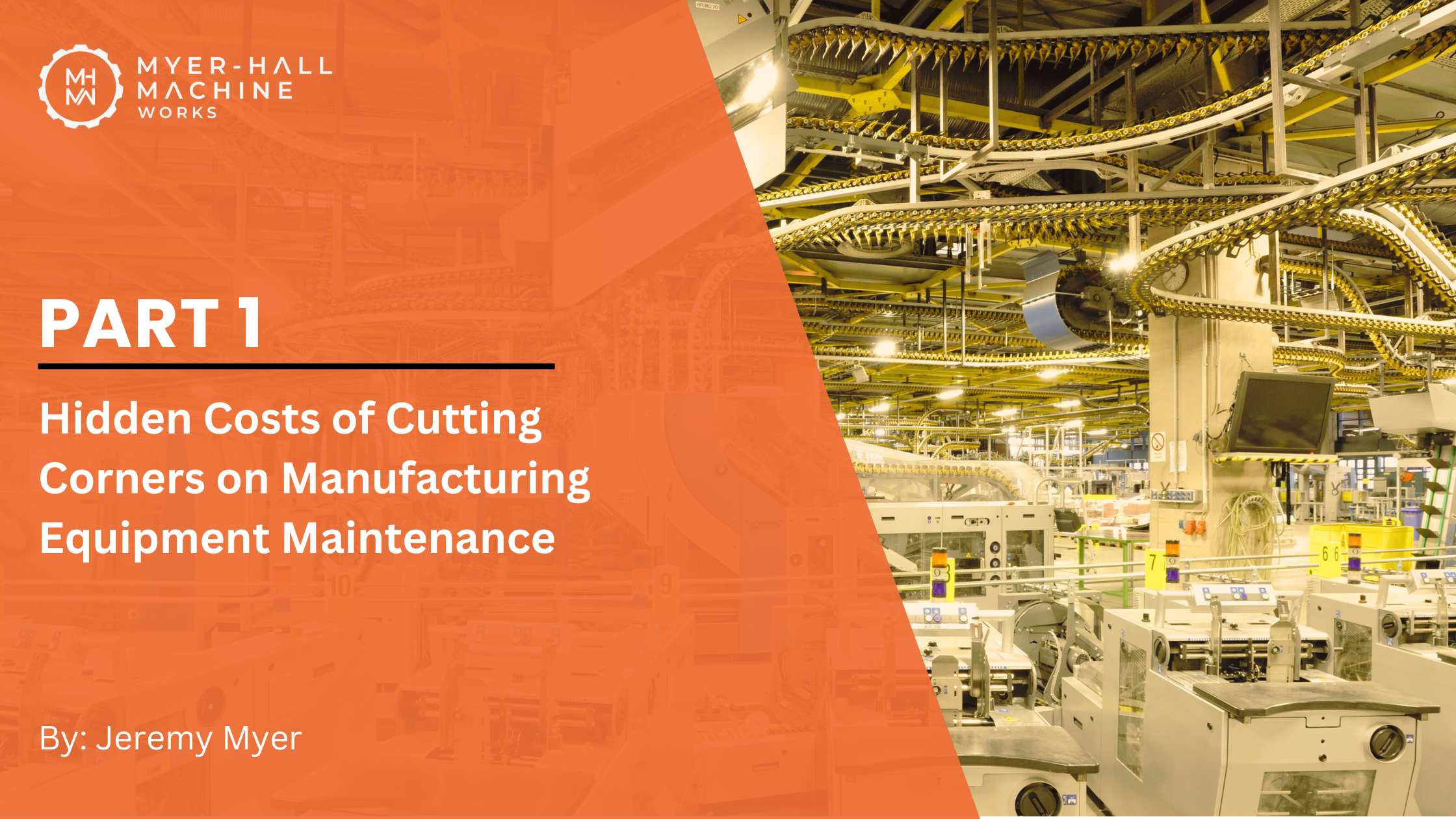PART 1: The Hidden Costs of Cutting Corners on Maintenance
December 9, 2024
In manufacturing, every decision is a balance between cost, time, and quality. Maintenance often finds itself on the chopping block, viewed as a non-critical expense that can be postponed. However, cutting corners on maintenance is not just a gamble—it’s a costly mistake that can ripple through every aspect of your operations.
Manufacturers who thrive in today’s increasingly competitive landscape recognize that proactive maintenance isn’t optional. It’s a business imperative, especially as machinery grows more complex and the stakes for downtime rise. Here’s why skipping regular maintenance can be far more expensive than it appears at first glance.
A Shifting Landscape: Why Maintenance Matters More Than Ever
The manufacturing industry has changed dramatically over the last few decades. Machines today are equipped with intricate electronics, sophisticated sensors, and interconnected systems. While these advancements enable higher productivity, they also make machinery more susceptible to cascading failures.
In the past, simpler machines with fewer moving parts could operate effectively with sporadic care. Minor faults often didn’t cascade into catastrophic breakdowns. Today, however, one worn bearing or overlooked component can cause a domino effect, shutting down an entire production line. In an industry where margins are razor-thin, even a few hours of downtime can erase profits for the day—and damage relationships with key customers.
This changing reality has shifted attitudes toward maintenance. Businesses are moving away from reactive “fix it when it breaks” strategies toward proactive approaches that emphasize regular inspections, component replacements, and system upgrades. Those who fail to adapt face compounding financial, operational, and reputational risks.
The Perception Problem: “We Don’t Have Time for Maintenance”
One of the most common reasons manufacturers delay maintenance is the perception that it takes too much time. The logic seems sound: shutting down production, even for scheduled maintenance, means losing valuable hours of output. However, this short-term thinking can lead to long-term consequences.
Unplanned downtime is far more costly than planned downtime. According to a 2022 Siemens True cost of Downtime Report, unplanned downtime costs Fortune Global 500 companies 11% of their yearly turnover – almost $1T. For smaller companies that have less staff, that percentage is likely higher.
“Breaking the costs down by sector, the cost of a lost hour now ranges from an average of $39,000 for factories producing Fast Moving Consumer Goods, to more than $2M an hour in Automotive.”
Similarly, according to the International Society of Automation, “the average manufacturing plant loses 5% – 20% of its annual productivity to unplanned downtime,” with a large number of smaller manufacturers not even being able to calculate the true impact due to redirecting resources to mitigating downtime over efficiency monitoring.
Take the analogy of a car: delaying an oil change might seem like a way to save money and time now, but when the engine fails due to neglect, the repair bill—and the time without your vehicle—grows. For manufacturers, the stakes are much higher. Emergency repairs often require overtime labor, expedited shipping for parts, and the diversion of skilled workers from other tasks.
Hidden Financial Costs of Neglect
- Energy Inefficiency
Poorly maintained machines consume more energy. A malfunctioning component forces the system to work harder, driving up utility bills. For example, under-lubricated motors or worn bearings can increase friction, requiring more power to achieve the same output. Over time, these inefficiencies quietly erode profitability.
- Cascading Failures
When one component fails, it often damages surrounding parts. A simple issue, such as a leaking hydraulic line, can lead to overheating, system shutdowns, or damage to other critical components. Neglecting a $50 replacement part can result in a $5,000 repair. I recently heard another seasoned professional say, “Pay me now, or pay me much more later,” and that hits the nail on the head when it comes to proactive maintenance versus reactive repairs.
- Workplace Safety and Liability
Maintenance is not just about machinery—it’s about people. Malfunctioning equipment increases the likelihood of workplace accidents. For example, worn components might cause sudden, erratic movements or leaks that create slippery surfaces. According to the Bureau of Labor Statistics, contact with objects and equipment accounted for over 700 fatalities in 2022. Preventive maintenance reduces these risks, protecting workers and the business from costly lawsuits and insurance claims.
- Reputational Damage
Customers and clients notice. If equipment issues delay production or lead to visible problems during facility tours, it raises concerns about reliability. This is particularly damaging in an industry where trust and consistency are key to retaining contracts. Poor maintenance practices can tarnish your reputation and push customers toward more reliable competitors.
The True Cost of Downtime
For small and mid-sized manufacturers, the financial implications of downtime can be staggering. Unplanned outages often create a cascade of costs, including:
- Overtime Wages: Workers need to stay late to catch up on lost production.
- Expedited Parts and Repairs: Emergency shipping and premium repair rates add up quickly.
- Lost Revenue: Orders go unfulfilled, leading to missed opportunities or penalties.
- Customer Dissatisfaction: Delayed shipments can result in lost contracts or reduced trust.
Even beyond these direct costs, downtime eats into margins at a time when competition has never been fiercer. Proactive maintenance directly addresses this gap, keeping operations running smoothly and avoiding unexpected disruptions.
Safety and Cultural Impacts of Downtime
In addition to the financial burden, neglecting maintenance affects workplace morale. Operators and technicians become frustrated with unreliable equipment, and constant breakdowns can create a culture of inefficiency and blame. Conversely, well-maintained machinery inspires confidence and pride, contributing to a positive work environment.
Safety is another critical factor. Just as a dull knife is more dangerous than a sharp one, poorly maintained machines increase the likelihood of accidents. Leaking oil, loose guards, or malfunctioning sensors can create hazardous conditions, leading to injuries, lawsuits, and regulatory fines. In extreme cases, these risks can even result in fatalities.
TO SUM UP: There Really Is a Competitive Advantage In Proactive Maintenance
In manufacturing, success hinges on small, incremental decisions that compound over time. Skipping maintenance feels like a way to save costs in the moment, but it’s a strategy that backfires—both financially and operationally. By investing in regular, proactive maintenance, manufacturers can:
- Reduce unplanned downtime and its associated costs.
- Improve energy efficiency and operational reliability.
- Protect workers and foster a culture of safety and professionalism.
- Safeguard their reputation with customers and partners.
In an industry driven by tight margins and fierce competition, every cent and second counts. Proactive maintenance isn’t just an operational choice—it’s a strategic one. It’s about controlling costs, minimizing risks, and positioning your business for long-term success. The hidden costs of neglect are simply too high to ignore.
For more insights into enhancing production through tailored solutions, subscribe to our blog (and follow on LinkedIn) to stay updated on strategies and industry trends.
 Written by Jeremy Myer, Co-Founder of Myer-Hall Machine Works.
Written by Jeremy Myer, Co-Founder of Myer-Hall Machine Works.

